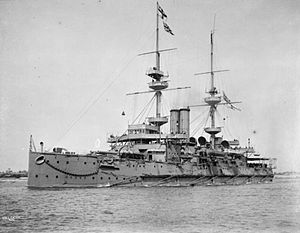HMS Caesar (1896)

HMS Caesar
|
|
| History | |
|---|---|
|
|
|
| Name: | HMS Caesar |
| Namesake: | Julius Caesar |
| Builder: | Portsmouth Dockyard |
| Laid down: | 25 March 1895 |
| Launched: | 2 September 1896 |
| Completed: | January 1898 |
| Commissioned: | 13 January 1898 |
| Decommissioned: | 23 April 1920 |
| Fate: | Sold for scrapping, 8 November 1921 |
| General characteristics | |
| Class and type: | Majestic-class pre-dreadnought battleship |
| Displacement: | 16,060 t (15,810 long tons; 17,700 short tons) |
| Length: | 421 ft (128 m) |
| Beam: | 75 ft (23 m) |
| Draught: | 27 ft (8.2 m) |
| Propulsion: | 2 × 3-cylinder triple expansion steam engines, twin screws |
| Speed: | 16 kn (30 km/h; 18 mph) |
| Complement: | 672 |
| Armament: |
|
| Armour: |
|
HMS Caesar was a Majestic-class pre-dreadnought battleship of the Royal Navy, named after the Roman military and political leader Julius Caesar. The ship was built at the Portsmouth Dockyard, starting with her keel laying in March 1895. She was launched in September 1896 and was commissioned into the fleet in January 1898. She was armed with a main battery of four 12-inch (300 mm) guns and a secondary battery of twelve 6-inch (150 mm) guns. The ship had a top speed of 16 knots (30 km/h; 18 mph).
Caesar served with the Mediterranean Fleet after a brief stint in the Channel Fleet. In 1905, she resumed service with a now re-organised Channel Fleet and was also part of the Atlantic Fleet for a time. In the service of the Home Fleet from 1907, she was placed in reserve in 1912. Following the outbreak of World War I, Caesar returned to the Channel Fleet before being transferred to the North America and West Indies Station in 1915 after a brief spell as a guard ship at Gibraltar. From 1918 to 1919 she served as a depot ship, firstly in the Mediterranean and Aegean Seas and then the Black Sea, in support of naval operations against the Bolsheviks. In this latter role, she was the last of the pre-dreadnought battleships to see service outside the United Kingdom. Returning to England in 1920, she was decommissioned and sold for scrap in 1921.
Caesar was 421 feet (128 m) long overall and had a beam of 75 ft (23 m) and a draft of 27 ft (8.2 m). She displaced up to 16,060 tonnes (15,810 long tons; 17,700 short tons) at full combat load. Her propulsion system consisted of two 3-cylinder triple expansion engines powered by eight coal-fired cylindrical boilers. By 1907–1908, she was re-boilered with oil-fired models. Her engines provided a top speed of 16 knots (30 km/h; 18 mph) at 10,000 indicated horsepower (7,500 kW). The Majestics were considered to have handled well, with an easy roll, although they suffered from high fuel consumption. She had a crew of 672 officers and enlisted men.
...
Wikipedia
